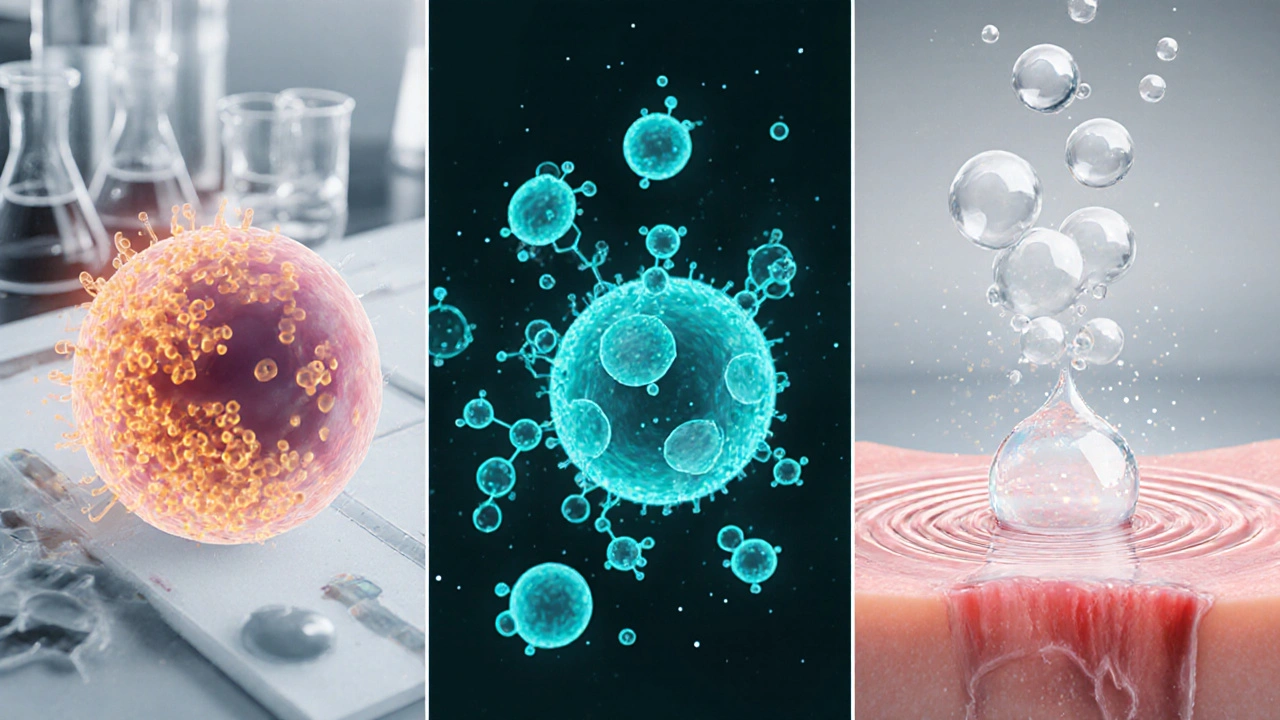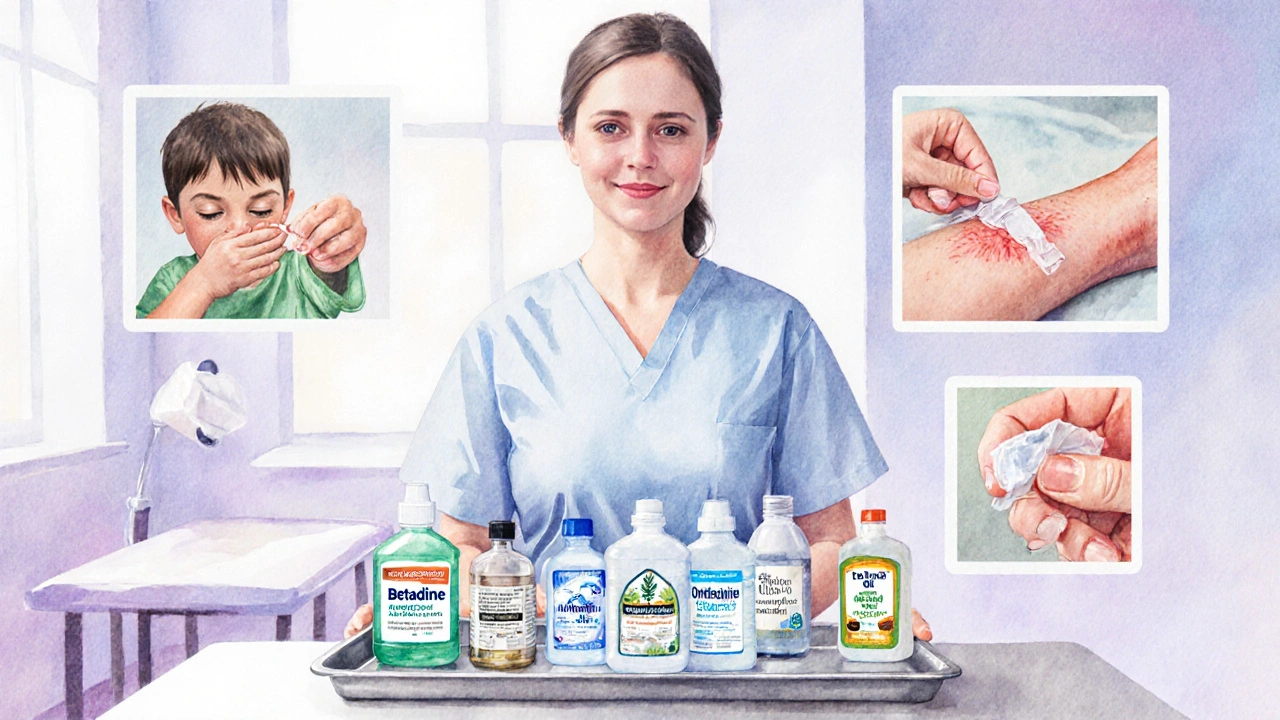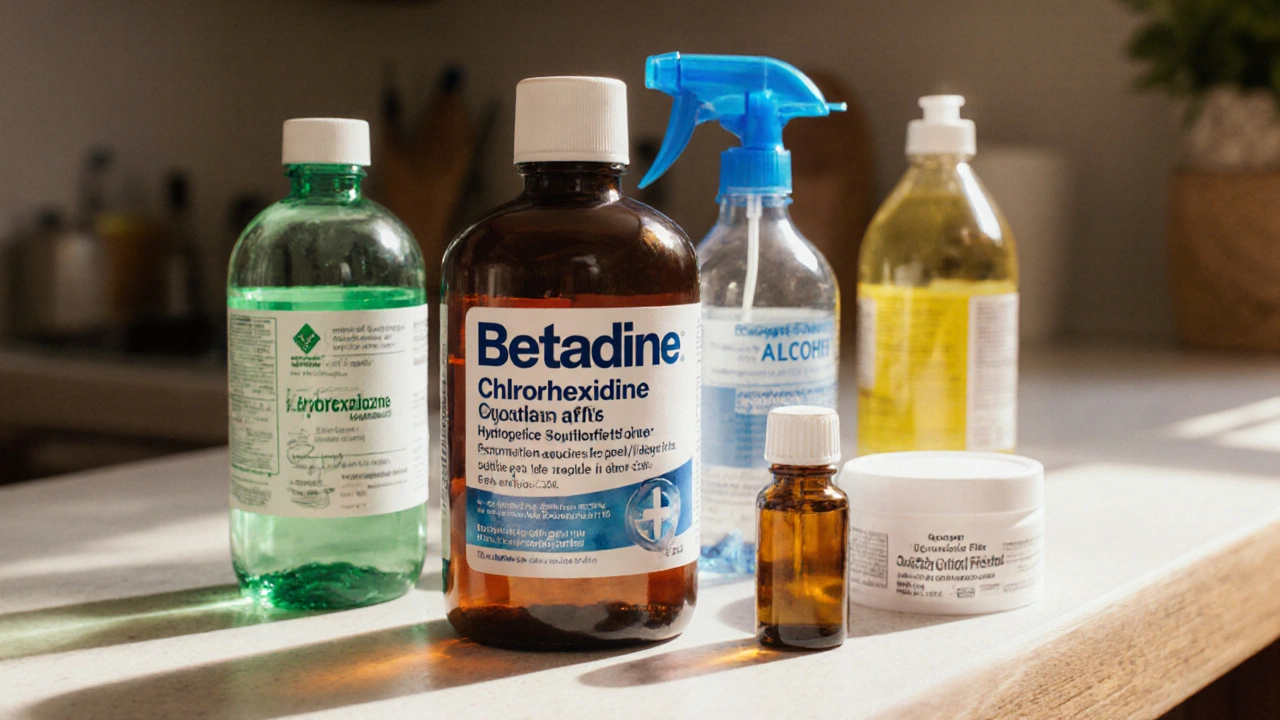Antiseptic Selection Guide
Why This Choice?
Antiseptic Comparison Table
| Antiseptic | Active Ingredient | Spectrum | Onset Time | Best For |
|---|
When you need to clean a cut, prep skin for surgery, or disinfect a minor burn, the first product that pops into most people’s heads is a brown bottle of Betadine. But the market is crowded with other antiseptics that promise similar or even better results. This article breaks down Betadine (povidone‑iodine) against the most common alternatives, so you can decide which one fits your needs, budget, and safety concerns.
What is Betadine (Povidone Iodine)?
Betadine is a povidone‑iodine solution that releases iodine to kill bacteria, viruses, fungi, and protozoa. First introduced in the 1950s, the brown‑amber liquid typically contains 10% w/v iodine complexed with povidone, which helps keep the iodine soluble and less irritating than plain iodine. Its broad‑spectrum activity makes it a staple in hospitals, first‑aid kits, and even some household medicine cabinets.
Popular Antiseptic Alternatives
Below are the main competitors you’ll find on pharmacy shelves or online. Each has a unique active ingredient, mode of action, and set of pros and cons.
- Chlorhexidine gluconate is a cationic antiseptic that disrupts microbial cell membranes, commonly sold as a 2% solution for surgical prep and wound care.
- Hydrogen peroxide is a oxidizing agent that generates free radicals to damage cellular components of microbes. Over‑the‑counter versions are typically 3%.
- Isopropyl alcohol (commonly 70% concentration) works by denaturing proteins and dissolving lipids in cell walls, providing rapid disinfection.
- Tea tree oil is a natural essential oil containing terpinen‑4‑ol, which interferes with microbial respiration. It’s sold in 5%-10% topical formulations.
- Silver sulfadiazine is a silver‑based cream that releases silver ions to inhibit bacterial DNA replication, mainly used for burns.
- Diluted sodium hypochlorite (household bleach at 0.05%-0.1%) acts as a strong oxidizer, useful for surface disinfection but rarely for direct skin contact.
How Each Antiseptic Works - The Science in Simple Terms
Betadine delivers iodine, which penetrates microbial proteins and nucleic acids, causing irreversible damage. The povidone carrier slows release, giving a longer contact time without the harsh burning sensation of tincture iodine.
Chlorhexidine sticks to cell walls because it’s positively charged, pulling apart the membrane and leaking essential contents. It also has a residual effect that lasts up to 6hours, which is why many surgeons prefer it for pre‑operative skin prep.
Hydrogen peroxide’s burst of oxygen - think fizzing on a wound - creates reactive oxygen species that oxidize lipids, proteins, and DNA. The effect is fast but short‑lived; the compound breaks down into water and oxygen within minutes.
Alcohol instantly coagulates proteins, wiping out most bacteria and viruses in under a minute. However, it evaporates quickly and offers no lingering protection.
Tea tree oil’s terpinen‑4‑ol disrupts the electron transport chain in microbial cells, making it a gentle, scent‑filled option for minor skin irritations.
Silver sulfadiazine releases silver ions that bind to bacterial enzymes, halting replication. It’s a slow‑acting but potent choice for deep burns.
Diluted bleach oxidizes everything it touches, killing microbes on contact. Because it’s harsh, it’s best kept off open wounds and used for surfaces only.
Efficacy Across Common Scenarios
Below is a quick look at how each antiseptic stacks up for three everyday uses: minor cuts, surgical skin prep, and burn treatment.
- Minor cuts and abrasions: Betadine, chlorhexidine, and hydrogen peroxide all clear bacteria effectively. Alcohol works but can sting and delay healing. Tea tree oil is soothing but less potent against resistant strains.
- Surgical skin preparation: Chlorhexidine outperforms Betadine in maintaining a sterile field after the initial wipe, thanks to its residual activity. Betadine is still acceptable, especially where iodine allergy is not a concern.
- Burn care: Silver sulfadiazine reigns supreme for deep second‑degree burns. Betadine can be used for superficial burns, but prolonged exposure may cause discoloration.

Safety, Side Effects, and Contra‑Indications
Every antiseptic carries some risk. Here’s a snapshot of the most common concerns.
- Betadine: Rare iodine allergy (0.1%); can cause thyroid dysfunction with extensive use; may stain skin and fabrics.
- Chlorhexidine: Skin irritation and rare anaphylaxis; does not kill spores; can be toxic if ingested.
- Hydrogen peroxide: Can delay wound healing if used repeatedly; may cause blistering at high concentrations.
- Alcohol: Extremely drying; fire hazard; painful on open wounds.
- Tea tree oil: Possible contact dermatitis for sensitive skin; photosensitivity is low but documented.
- Silver sulfadiazine: Can cause leukopenia in prolonged use; not suitable for patients with sulfa allergy.
- Diluted bleach: Irritating; must be rinsed thoroughly if accidentally applied to skin.
Cost, Availability, and Practical Tips
In Australia, Betadine 10% solution sells for roughly AU$10-15 per 100ml bottle, available in pharmacies, supermarkets, and online. Chlorhexidine wound wash is a bit pricier at AU$12-18 for a 100ml bottle, but many hospitals provide it for free to patients.
Hydrogen peroxide and alcohol are the cheapest options, usually under AU$5 for a 250ml bottle, but you’ll need to remember they evaporate quickly.
Tea tree oil and silver sulfadiazine sit in the mid‑range, AU$8-12 per 30ml tube and AU$15-20 per 100g tube respectively.
Practical tip: keep a small Betadine bottle for emergency cuts, a chlorhexidine wipe pack for pre‑op prep (or travel), and an alcohol swab pack for quick disinfection of skin before injections.
Decision Guide - When to Choose Betadine or an Alternative
The table below summarizes the key attributes that matter most when you’re weighing your options.
| Antiseptic | Active Ingredient | Typical Concentration | Spectrum | Onset | Common Uses | Approx. Cost (AU$) |
|---|---|---|---|---|---|---|
| Betadine | Iodine (povidone‑iodine) | 10% w/v | Broad (bacteria, virus, fungi, protozoa) | 1‑2min | Wound cleaning, surgical prep, burns (minor) | 10‑15 |
| Chlorhexidine | Chlorhexidine gluconate | 2% solution | Broad (bacteria, some viruses) | 30‑60sec | Surgical prep, catheter sites, diaper rash | 12‑18 |
| Hydrogen Peroxide | H₂O₂ | 3% solution | Moderate (bacteria, viruses) | Immediate (fizz) | Minor cuts, oral rinse | 3‑5 |
| Isopropyl Alcohol | Isopropanol | 70% v/v | Broad (bacteria, viruses) | Under 30sec | Skin prep before injections, surface disinfection | 4‑6 |
| Tea Tree Oil | Terpinen‑4‑ol (5‑10% blend) | 5‑10% in carrier | Moderate (bacteria, fungi) | 5‑10min | Acne, minor fungal infections, soothing creams | 8‑12 |
| Silver Sulfadiazine | Silver sulfadiazine | 1% cream | Broad (bacteria, some fungi) | 15‑30min | Burns, chronic wounds | 15‑20 |
| Diluted Bleach | Sodium hypochlorite | 0.05%‑0.1% | Broad (bacteria, viruses, spores) | Immediate | Surface disinfection, wound irrigation (medical only) | 2‑4 |
Quick Takeaways
- Betadine offers a reliable, broad‑spectrum kill with a moderate cost and easy shelf life.
- Chlorhexidine wins for lasting protection on surgical sites but can irritate sensitive skin.
- Alcohol gives the fastest kill but dries out tissue and offers no residual effect.
- Silver sulfadiazine is the go‑to for serious burns, while tea tree oil is a gentle, natural option for minor skin issues.
- Budget‑friendly choices like hydrogen peroxide or diluted bleach work for surface cleaning but are less suited for open wounds.
Frequently Asked Questions
Can I use Betadine on a deep wound?
Betadine is safe for superficial cuts and minor abrasions, but for deep or heavily contaminated wounds a sterile saline rinse followed by a more specialized dressing (like silver sulfadiazine) is usually recommended.
Is chlorhexidine better than Betadine for pre‑surgical skin prep?
Many hospitals prefer chlorhexidine because it leaves a residual antimicrobial layer that lasts several hours, whereas Betadine’s effect drops off quicker. However, if a patient has a known iodine allergy, chlorhexidine is the safer choice.
Will alcohol sting when applied to an open cut?
Yes. Alcohol evaporates rapidly and destroys nerve endings, which feels like a sharp sting. It also dries the tissue, potentially slowing healing.
Are there any age restrictions for using povidone‑iodine?
Povidone‑iodine is generally safe for children over 6 months, but infants younger than that can absorb iodine systemically, raising concerns about thyroid function.
How long does Betadine stay effective after opening?
An unopened bottle lasts up to 3years. Once opened, keep it tightly capped and store in a cool, dark place; it remains potent for about 12months.

Next Steps & Troubleshooting
If you’re unsure which antiseptic to grab, follow this quick flow:
- Is the wound deep or a burn? → Choose silver sulfadiazine (burn) or saline + specialist dressing (deep).
- Do you need fast‑acting prep for an injection or a minor cut? → Alcohol for the fastest kill, but expect a sting.
- Looking for broad coverage with lingering protection? → Chlorhexidine is your best bet.
- Prefer a budget‑friendly, readily available option? → Hydrogen peroxide or diluted bleach (surface only).
- Want a natural scent and mild action? → Tea tree oil works for mild skin irritations.
Remember to watch for allergic reactions-any redness, swelling, or breathing difficulty warrants immediate medical attention.
With the facts laid out, you can match the right antiseptic to the situation without guessing. Whether you stick with the trusty brown bottle of Betadine or opt for a newer alternative, the key is using it correctly and safely.


16 Comments
Betadine is the OG antiseptic, but the rest are just flashy copycats!
When delineating the pharmacodynamic landscape of topical antimicrobials, povidone‑iodine occupies a singular niche characterized by a veritable panoply of microbicidal mechanisms, ranging from protein denaturation to nucleic acid oxidation. Its amphiphilic complex facilitates sustained iodine release, thereby extending the biocidal window beyond that of aqueous halogen donors. Conversely, chlorhexidine gluconate, whilst lauded for cationic membrane disruption, suffers from a paucity of virucidal efficacy against non‑enveloped viruses, rendering it suboptimal in certain nosocomial contexts. Hydrogen peroxide’s oxidative burst, albeit rapid, is hampered by its ephemerality, as the liberated nascent oxygen dissipates within seconds, curtailing any residual activity. Isopropyl alcohol, the prototypical solvent, achieves near‑instantaneous bacterial kill kinetics, yet its desiccating propensity precipitates delayed epithelialization. Tea tree oil, an oleoresinous extract, proffers a modest spectrum targeting dermatophytic fungi, but its phytochemical variability undermines reproducibility across commercial formulations. Silver sulfadiazine, a silver‑based carbamate, boasts formidable efficacy against burn‑associated pathogens, albeit at the expense of delayed re‑epithelialization. Diluted sodium hypochlorite manifests a potent oxidizing milieu capable of sporicidal action, though its cytotoxic profile precludes direct cutaneous application. Economically, Betadine resides in a median price bracket, offering a cost‑effective compromise between affordability and broad‑spectrum coverage. In terms of shelf stability, the iodine‑povidone matrix confers a triannual viability post‑opening, surpassing the volatility of alcohol‑based preparations. Clinical guidelines frequently endorse Betadine for pre‑operative skin antisepsis, albeit with the caveat of potential iodinated staining. Patient tolerance metrics reveal a marginally reduced nociceptive response relative to chlorhexidine, yet heightened caution is warranted in individuals with iodine hypersensitivity. From a regulatory perspective, povidone‑iodine enjoys universal inclusion within WHO essential medicines lists, whereas certain chlorhexidine formulations remain regionally restricted. The cumulative evidence thus suggests a stratified approach: employ Betadine for routine wound care, reserve chlorhexidine for procedures demanding prolonged antimicrobial presence, and allocate silver sulfadiazine to deep second‑degree burns. Ultimately, the adjudication of antiseptic selection must integrate pharmacokinetic parameters, patient comorbidities, and fiscal considerations to optimize therapeutic outcomes.
Betadine does the job it's cheap enough but iodine allergies exist its spectrum is wide however chlorhexidine lasts longer and alcohol works faster but dries skin.
Oh sure, grab the brown bottle because who doesn’t love a little orange‑brown mystery liquid on a fresh cut? In reality, the iodine complexes in Betadine are pretty solid at knocking out bacteria, viruses, even fungi, and the povidone carrier keeps the sting down a notch. If you’re prepping for surgery, though, you might want the lingering bite of chlorhexidine – it sticks around like that one friend who never leaves the party. For minor scrapes, a quick dab of Betadine does the trick, just remember to rinse after a few minutes to avoid staining. And if you’re trying to impress your friends with “natural” remedies, tea tree oil smells nice but it won’t replace a proper antiseptic. Bottom line: use what’s appropriate for the wound depth and your tolerance, not just what looks cooler on the shelf.
While the article admirably enumerates the various antiseptic agents, it regrettably glosses over the nuanced pharmacokinetic profiles, thereby presenting an oversimplified, albeit aesthetically pleasing, tableau; moreover, the cost analysis, though useful, fails to account for regional pricing disparities, which could mislead readers seeking budget‑friendly options; consequently, a more rigorous comparative framework would have elevated the discourse.
Betadine’s the hero, but the villains? They’re just cheap knock‑offs.
Great, another guide that tells me I can just buy a bottle of brown goo and feel like a surgeon – thanks for the confidence boost 😂
Interesting breakdown, especially the part about iodine allergies – something I hadn’t thought about before.
I think the best approach is to match the antiseptic to the specific situation rather than sticking to one brand for everything.
The comparative efficacy of povidone‑iodine versus chlorhexidine in surgical skin preparation warrants further investigation, particularly regarding residual antimicrobial activity over time.
For anyone new to wound care, think of antiseptics as a toolbox: Betadine is your all‑purpose screwdriver, chlorhexidine your power drill, and silver sulfadiazine the specialized wrench for burn repairs.
We keep debating cheap antiseptics like they’re the ultimate moral choice, but in truth the chemistry decides – if you want speed, grab alcohol; if you want stay‑power, chlorhexidine; if you want breadth, Betadine.
Sorry you’re dealing with a nasty cut – Betadine should help clean it up, just be gentle and keep an eye on any redness 😊
Behold the regal brown elixir, Betadine, whose venerable presence has graced medical cabinets since the dawn of modern antisepsis; yet, let us not be blinded by its storied past, for newer agents may yet surpass it in efficacy and tolerance.
From a pharmacological standpoint, the iodophor complex in Betadine releases free iodine in a controlled manner, achieving a log‑reduction in microbial load comparable to chlorhexidine’s cationic disruption, albeit with differing cytotoxicity profiles that must be factored into clinical decision‑making.
While the exhaustive exposition you provided sounds impressive, it's hard to ignore the subtle agenda pushing commercial iodine products over equally viable alternatives, a narrative that seems orchestrated by hidden stakeholders.